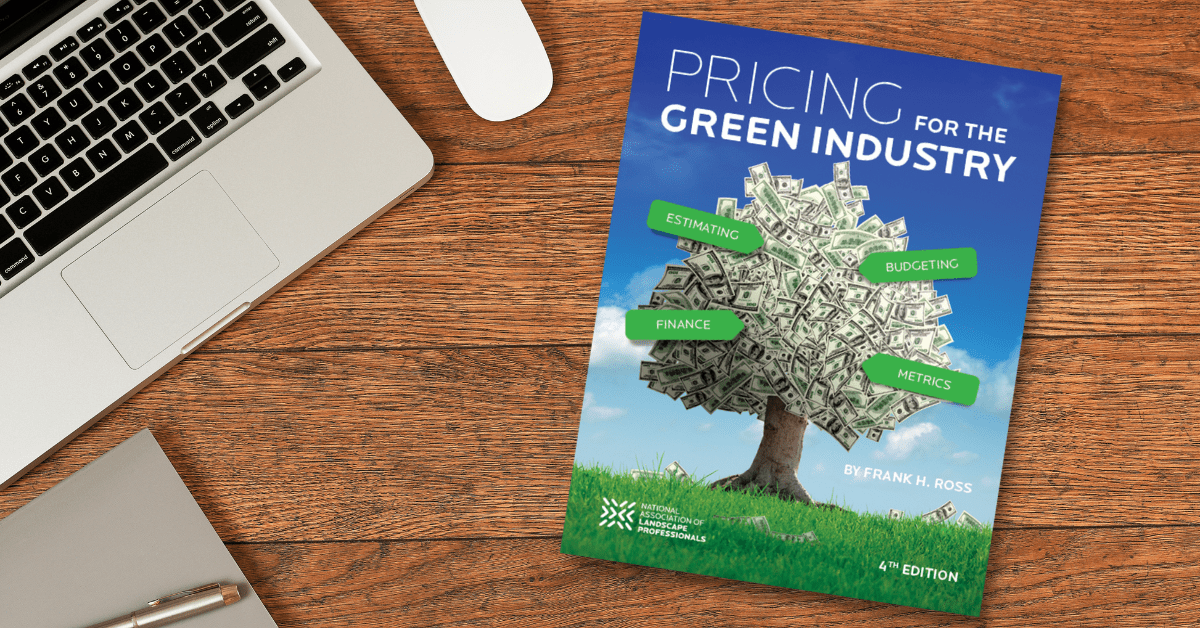
If you’re like many landscape professionals, you got into this industry because you love being outside and enjoy working with plants and growing your people. As you launched your business and refined your skills, one aspect that might have been neglected is the company’s financial side.
The book, Pricing for the Green Industry, 4th edition, by Frank Ross is a financial text written for the non-financial manager.
“This text is an effort to introduce the art of financial management to those owners and managers who have the responsibility for creating revenue and/or spending money,” Ross says. “Its intent is to blow the smoke away from the mysteries of finance and to add the incredibility powerful tool of controlling our numbers to our tool chest.”
The book covers what tools you must have to price successfully, valid pricing methods, how to package your pricing and much more. Ross says that even veterans of the industry need financial management. He encourages asking yourself how much profit do you put on every job you bid and how much profit do you generate on your P&L at year-end?
“If the year-end performance is not greater than the profit you put into your bids, you have a misery,” Ross says. “Understanding the numbers can help you identify the misery and put you on the path of creating solutions.”
For those who have purchased previous editions of the book, Ross says they have added new sections and brought the text up to date with current values and events.
“Specifically, with this current edition, we have added a financial metric section that addresses and explains some 36 financial indicators that are relevant to the successes of all of our companies,” he says.
Ross also breaks down pricing myths, including pricing with the mindset of ‘what the market will bear.’
“This practice is extremely dangerous and often times results in disastrous results,” Ross says. “Why? Common sense, really. Just because someone out there says they can perform a job at a certain price doesn’t mean we can. Pricing is a pragmatic process and is based upon unique characteristics in each of our companies. Our success will be founded upon how well we measure those characteristics and mold them into the pricing of every job we propose.”
The book covers building your budget before pricing and why more companies should create an annual budget. Ross says many will cite there are just too many variables to create an accurate budget and others make the mistake of building a budget from the top down. He argues owners need to build it from the bottom up, starting with the amount of profit necessary to generate cash flow.
“If we add the profit requirement together with the overhead we anticipate, the result is the gross margin we must generate to cover our standard of living and appropriately cash flow the business,” Ross says. “Next, depending upon our markets and associated cost structures, we can determine how much revenue we have to generate (not will generate) if we expect a successful result. We can also determine what refinements to our pricing strategies are required to make sure every job makes a proportionate contribution to the gross margin goals we have established. If we then track our actual performance month over month against our budget, we will be able to navigate any unforeseens quite efficiently.”
As for where Ross sees the future of pricing headed over the next five years, he admits much depends on factors outside our control, but he expects prices to continue to go up. He suggests maintaining a consistent labor leverage metric that should be flat or increase slightly year over year to remain profitable.
“Labor Leverage is a simple metric, actually,” he says. “Take the revenue generated by an hour of labor divided by the cost per hour. So, if we sell an hour for $45 and our raw cost per hour is $20 per hour … $45 divided by $20 gives us a leverage of 2.25. A translation of this metric is that for every $1.00 labor cost goes up, the sell rate must go up $2.25 if we are to maintain profit consistency.”
As landscape companies brace for the predicted economic turbulence, Ross encourages practicing common sense in the form of reducing debt, being conservative with capital expenditures, monitoring fixed overhead growth and tracking your numbers.
He recommends practicing constant improvement when it comes to estimating, budgeting and pricing.
“In estimating, always monitor the labor performance standards and make changes where efficiencies can be realized / update material costs on a job by job basis / make sure we know how much profit is estimated on every job we sell,” Ross says. “Then monitor the performance of every job as to the revenue per hour it generates against our selling standard. If there is a deviation from the standard, determine the ‘why’ and make sure we adjust.”
Take advantage of NALP’s new free shipping in the continental United States and order this book and others from NALP’s bookstore.

